Pharmacology and Pathophysiology: Benji's Asthma Case Study Analysis
VerifiedAdded on 2022/08/27
|12
|3125
|20
Case Study
AI Summary
This case study examines the pharmacology and pathophysiology of asthma through the case of an 11-year-old boy named Benji. Benji, diagnosed with asthma at age 7, presents with severe symptoms following a cold. The study delves into the pathophysiology of asthma, discussing how environmental triggers and infections lead to airway inflammation, constriction, and mucus production, causing breathing difficulties. It explores the immunological mechanisms involved, including the role of IgE and the release of histamine and prostaglandins. The case study identifies and discusses three key signs and symptoms: wheezing, breathlessness, and tachycardia, linking them to the underlying physiological processes. It then details the pharmacological interventions used, including Salbutamol, Prednisolone, and Ipratropium, providing an explanation of their pharmacodynamics and pharmacokinetics, and relating these medications to the alleviation of Benji's symptoms. The study references various research articles to support its findings, offering a comprehensive overview of asthma management.

Running head: PHARMACOLOGY AND PATHOPHYSIOLOGY
PHARMACOLOGY AND PATHOPHYSIOLOGY
Name of the student:
Name of the university:
Author note:
PHARMACOLOGY AND PATHOPHYSIOLOGY
Name of the student:
Name of the university:
Author note:
Paraphrase This Document
Need a fresh take? Get an instant paraphrase of this document with our AI Paraphraser

1PHARMACOLOGY AND PATHOPHYSIOLOGY
A detailed explanation of the pathophysiology:
With the global burden of chronic disease, asthma considered as the leading cause of
respiratory illness associated illness around the globe. Asthma has emerged as a frequent
pulmonary disorder described by prolonged inflammation of respiratory tubes, constriction of
respiratory smooth muscle as well as occurrences of bronchoconstriction (Craft & Gordon 2019).
The case study involves an 11 -year-old boy, Benji with asthma diagnosed at age 7. Benji
presented to the hospital due to the severe asthma progression. On presentation, he had
communication difficulties and had a clear wheeze. His mother who suggested that Benji had
history of asthma and exhibited wheezing, difficulty in breathing and coughing. Considering the
pathophysiology, due to environmental triggers such as pollen, bacteria and dust, inflammation
of airway observed that leads to intermittent airflow obstruction. In this context, the risk factors
for triggering asthma amongst patients include tobacco smoke, ozone, and particulate matter that
has the potential to induce airway inflammation. The case study suggested that Benji was well
until he caught a cold, indicating the catching cold might be the reason behind the development
of upper respiratory infection. Bacterial infections can damage mucociliary clearance and
increase mucus production in the lung which may result in lower airway inflammation (Teo et
al., 2018). Therefore, Muscles of airways tighten and swelling of airway linings observed.
Additional secretion of mucus in the airways that can block the air tubes and lungs. The airway
narrow down and accumulation of mucous leads to breathing difficulties. Mucous encompasses
cellular debris of ecrotic airway epithelial cells, inflammatory cells (Tan et al., 2020).
Considering the immunological mechanisms, Cheung, Choo and Perrett (2019), suggested that
due to presence of allergen ( antigen like a viral or bacterial particle), the immune system
overreacts to the allergen by releasing IgE and the antigen binds to IgE receptors which resulted
A detailed explanation of the pathophysiology:
With the global burden of chronic disease, asthma considered as the leading cause of
respiratory illness associated illness around the globe. Asthma has emerged as a frequent
pulmonary disorder described by prolonged inflammation of respiratory tubes, constriction of
respiratory smooth muscle as well as occurrences of bronchoconstriction (Craft & Gordon 2019).
The case study involves an 11 -year-old boy, Benji with asthma diagnosed at age 7. Benji
presented to the hospital due to the severe asthma progression. On presentation, he had
communication difficulties and had a clear wheeze. His mother who suggested that Benji had
history of asthma and exhibited wheezing, difficulty in breathing and coughing. Considering the
pathophysiology, due to environmental triggers such as pollen, bacteria and dust, inflammation
of airway observed that leads to intermittent airflow obstruction. In this context, the risk factors
for triggering asthma amongst patients include tobacco smoke, ozone, and particulate matter that
has the potential to induce airway inflammation. The case study suggested that Benji was well
until he caught a cold, indicating the catching cold might be the reason behind the development
of upper respiratory infection. Bacterial infections can damage mucociliary clearance and
increase mucus production in the lung which may result in lower airway inflammation (Teo et
al., 2018). Therefore, Muscles of airways tighten and swelling of airway linings observed.
Additional secretion of mucus in the airways that can block the air tubes and lungs. The airway
narrow down and accumulation of mucous leads to breathing difficulties. Mucous encompasses
cellular debris of ecrotic airway epithelial cells, inflammatory cells (Tan et al., 2020).
Considering the immunological mechanisms, Cheung, Choo and Perrett (2019), suggested that
due to presence of allergen ( antigen like a viral or bacterial particle), the immune system
overreacts to the allergen by releasing IgE and the antigen binds to IgE receptors which resulted
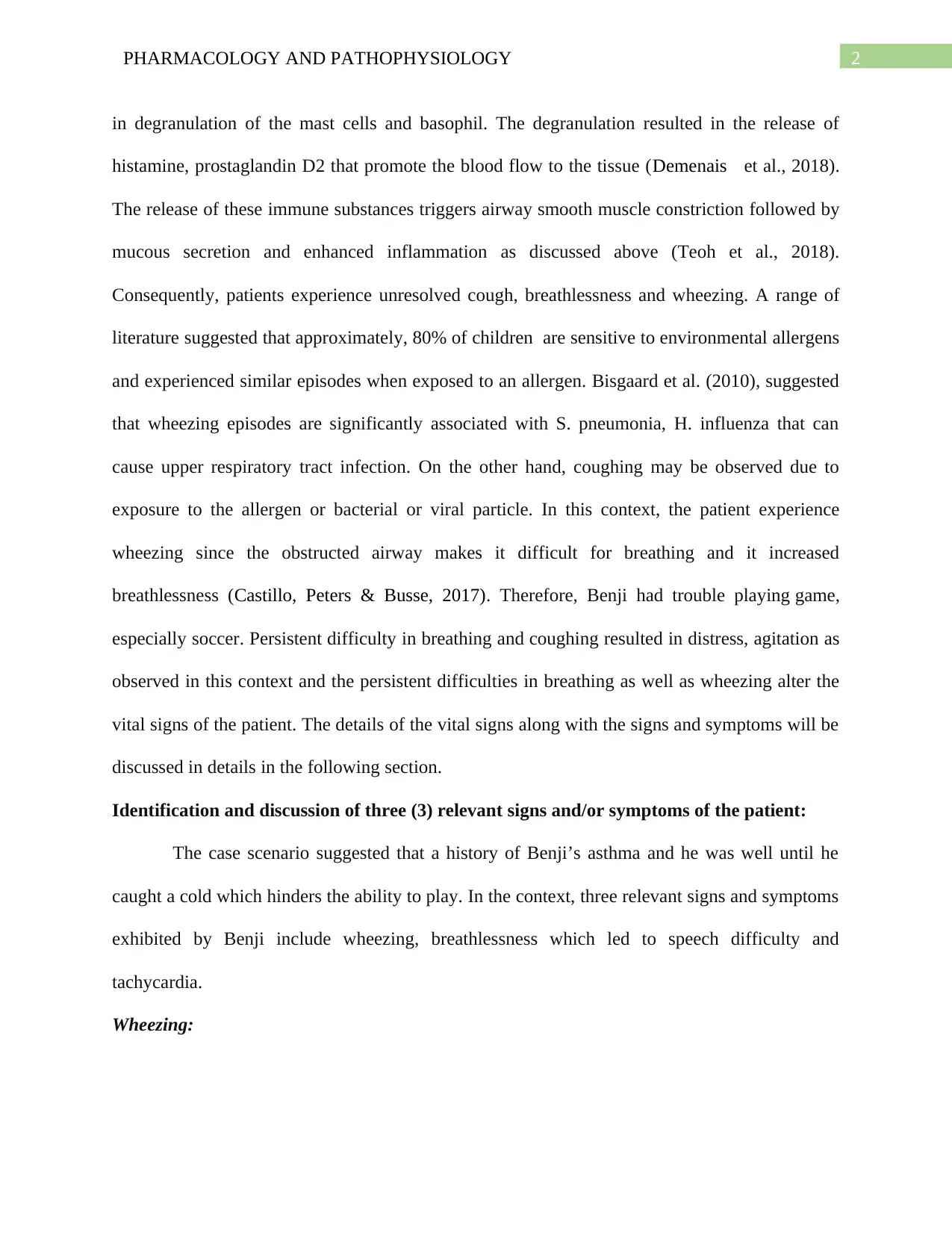
2PHARMACOLOGY AND PATHOPHYSIOLOGY
in degranulation of the mast cells and basophil. The degranulation resulted in the release of
histamine, prostaglandin D2 that promote the blood flow to the tissue (Demenais et al., 2018).
The release of these immune substances triggers airway smooth muscle constriction followed by
mucous secretion and enhanced inflammation as discussed above (Teoh et al., 2018).
Consequently, patients experience unresolved cough, breathlessness and wheezing. A range of
literature suggested that approximately, 80% of children are sensitive to environmental allergens
and experienced similar episodes when exposed to an allergen. Bisgaard et al. (2010), suggested
that wheezing episodes are significantly associated with S. pneumonia, H. influenza that can
cause upper respiratory tract infection. On the other hand, coughing may be observed due to
exposure to the allergen or bacterial or viral particle. In this context, the patient experience
wheezing since the obstructed airway makes it difficult for breathing and it increased
breathlessness (Castillo, Peters & Busse, 2017). Therefore, Benji had trouble playing game,
especially soccer. Persistent difficulty in breathing and coughing resulted in distress, agitation as
observed in this context and the persistent difficulties in breathing as well as wheezing alter the
vital signs of the patient. The details of the vital signs along with the signs and symptoms will be
discussed in details in the following section.
Identification and discussion of three (3) relevant signs and/or symptoms of the patient:
The case scenario suggested that a history of Benji’s asthma and he was well until he
caught a cold which hinders the ability to play. In the context, three relevant signs and symptoms
exhibited by Benji include wheezing, breathlessness which led to speech difficulty and
tachycardia.
Wheezing:
in degranulation of the mast cells and basophil. The degranulation resulted in the release of
histamine, prostaglandin D2 that promote the blood flow to the tissue (Demenais et al., 2018).
The release of these immune substances triggers airway smooth muscle constriction followed by
mucous secretion and enhanced inflammation as discussed above (Teoh et al., 2018).
Consequently, patients experience unresolved cough, breathlessness and wheezing. A range of
literature suggested that approximately, 80% of children are sensitive to environmental allergens
and experienced similar episodes when exposed to an allergen. Bisgaard et al. (2010), suggested
that wheezing episodes are significantly associated with S. pneumonia, H. influenza that can
cause upper respiratory tract infection. On the other hand, coughing may be observed due to
exposure to the allergen or bacterial or viral particle. In this context, the patient experience
wheezing since the obstructed airway makes it difficult for breathing and it increased
breathlessness (Castillo, Peters & Busse, 2017). Therefore, Benji had trouble playing game,
especially soccer. Persistent difficulty in breathing and coughing resulted in distress, agitation as
observed in this context and the persistent difficulties in breathing as well as wheezing alter the
vital signs of the patient. The details of the vital signs along with the signs and symptoms will be
discussed in details in the following section.
Identification and discussion of three (3) relevant signs and/or symptoms of the patient:
The case scenario suggested that a history of Benji’s asthma and he was well until he
caught a cold which hinders the ability to play. In the context, three relevant signs and symptoms
exhibited by Benji include wheezing, breathlessness which led to speech difficulty and
tachycardia.
Wheezing:
⊘ This is a preview!⊘
Do you want full access?
Subscribe today to unlock all pages.

Trusted by 1+ million students worldwide
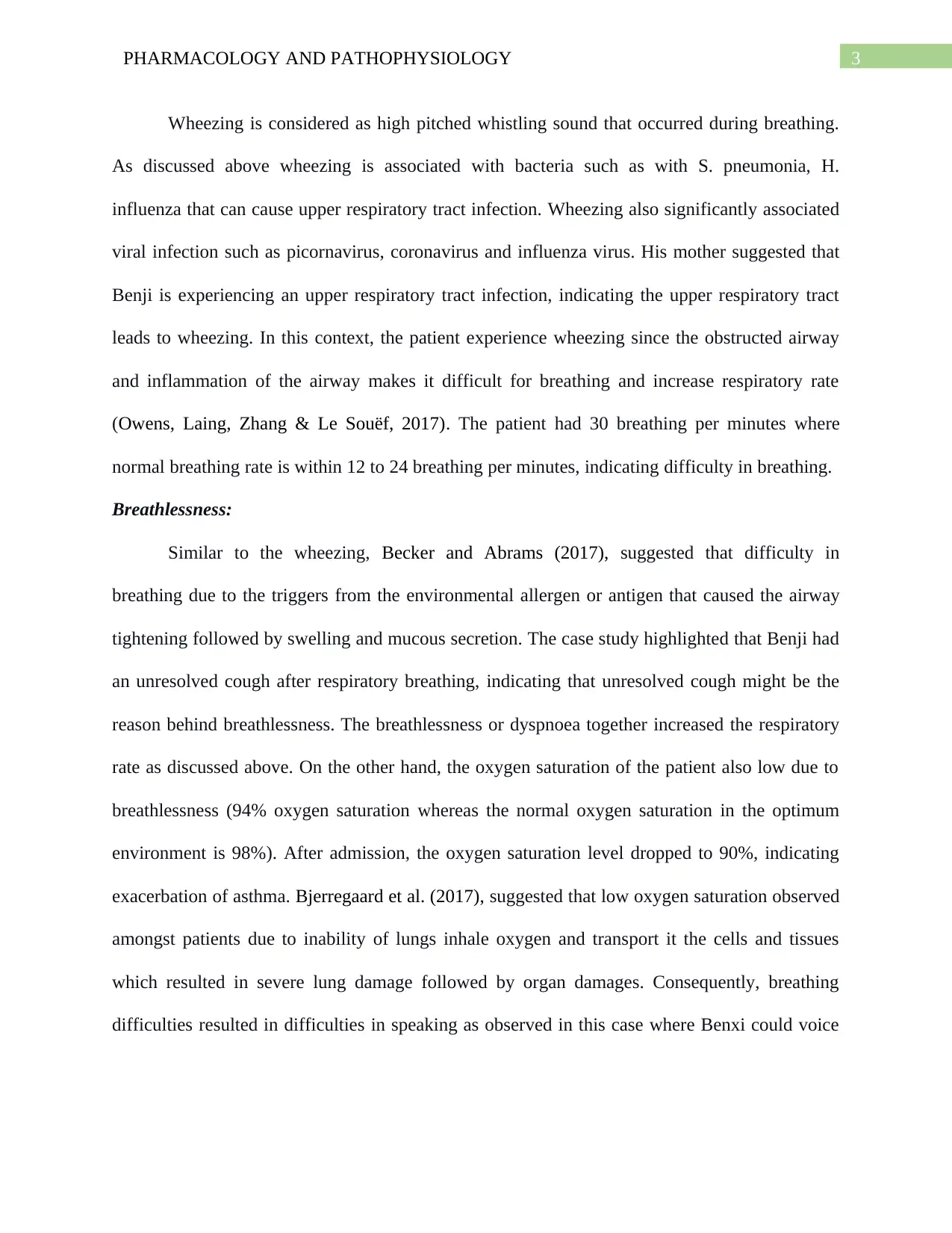
3PHARMACOLOGY AND PATHOPHYSIOLOGY
Wheezing is considered as high pitched whistling sound that occurred during breathing.
As discussed above wheezing is associated with bacteria such as with S. pneumonia, H.
influenza that can cause upper respiratory tract infection. Wheezing also significantly associated
viral infection such as picornavirus, coronavirus and influenza virus. His mother suggested that
Benji is experiencing an upper respiratory tract infection, indicating the upper respiratory tract
leads to wheezing. In this context, the patient experience wheezing since the obstructed airway
and inflammation of the airway makes it difficult for breathing and increase respiratory rate
(Owens, Laing, Zhang & Le Souëf, 2017). The patient had 30 breathing per minutes where
normal breathing rate is within 12 to 24 breathing per minutes, indicating difficulty in breathing.
Breathlessness:
Similar to the wheezing, Becker and Abrams (2017), suggested that difficulty in
breathing due to the triggers from the environmental allergen or antigen that caused the airway
tightening followed by swelling and mucous secretion. The case study highlighted that Benji had
an unresolved cough after respiratory breathing, indicating that unresolved cough might be the
reason behind breathlessness. The breathlessness or dyspnoea together increased the respiratory
rate as discussed above. On the other hand, the oxygen saturation of the patient also low due to
breathlessness (94% oxygen saturation whereas the normal oxygen saturation in the optimum
environment is 98%). After admission, the oxygen saturation level dropped to 90%, indicating
exacerbation of asthma. Bjerregaard et al. (2017), suggested that low oxygen saturation observed
amongst patients due to inability of lungs inhale oxygen and transport it the cells and tissues
which resulted in severe lung damage followed by organ damages. Consequently, breathing
difficulties resulted in difficulties in speaking as observed in this case where Benxi could voice
Wheezing is considered as high pitched whistling sound that occurred during breathing.
As discussed above wheezing is associated with bacteria such as with S. pneumonia, H.
influenza that can cause upper respiratory tract infection. Wheezing also significantly associated
viral infection such as picornavirus, coronavirus and influenza virus. His mother suggested that
Benji is experiencing an upper respiratory tract infection, indicating the upper respiratory tract
leads to wheezing. In this context, the patient experience wheezing since the obstructed airway
and inflammation of the airway makes it difficult for breathing and increase respiratory rate
(Owens, Laing, Zhang & Le Souëf, 2017). The patient had 30 breathing per minutes where
normal breathing rate is within 12 to 24 breathing per minutes, indicating difficulty in breathing.
Breathlessness:
Similar to the wheezing, Becker and Abrams (2017), suggested that difficulty in
breathing due to the triggers from the environmental allergen or antigen that caused the airway
tightening followed by swelling and mucous secretion. The case study highlighted that Benji had
an unresolved cough after respiratory breathing, indicating that unresolved cough might be the
reason behind breathlessness. The breathlessness or dyspnoea together increased the respiratory
rate as discussed above. On the other hand, the oxygen saturation of the patient also low due to
breathlessness (94% oxygen saturation whereas the normal oxygen saturation in the optimum
environment is 98%). After admission, the oxygen saturation level dropped to 90%, indicating
exacerbation of asthma. Bjerregaard et al. (2017), suggested that low oxygen saturation observed
amongst patients due to inability of lungs inhale oxygen and transport it the cells and tissues
which resulted in severe lung damage followed by organ damages. Consequently, breathing
difficulties resulted in difficulties in speaking as observed in this case where Benxi could voice
Paraphrase This Document
Need a fresh take? Get an instant paraphrase of this document with our AI Paraphraser
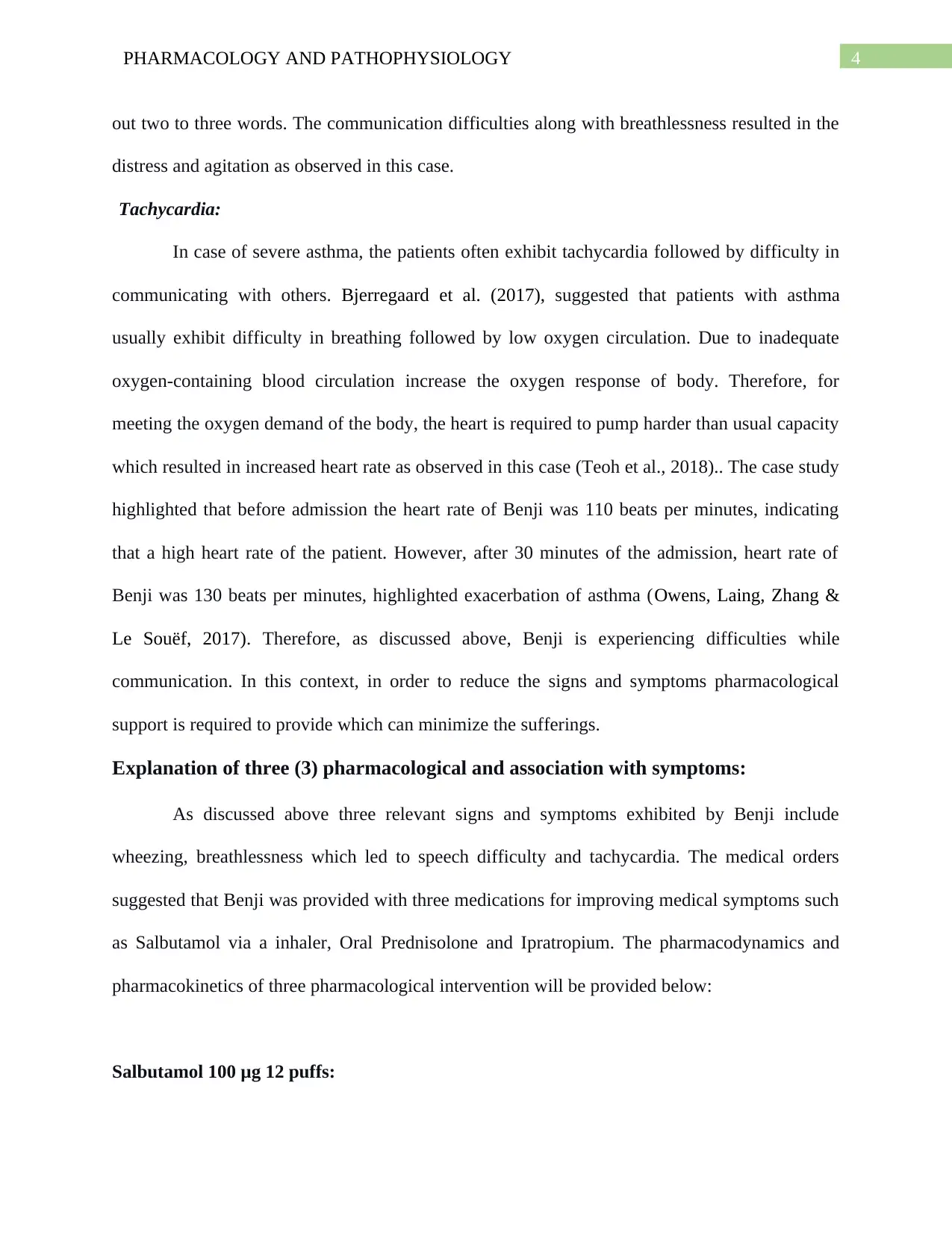
4PHARMACOLOGY AND PATHOPHYSIOLOGY
out two to three words. The communication difficulties along with breathlessness resulted in the
distress and agitation as observed in this case.
Tachycardia:
In case of severe asthma, the patients often exhibit tachycardia followed by difficulty in
communicating with others. Bjerregaard et al. (2017), suggested that patients with asthma
usually exhibit difficulty in breathing followed by low oxygen circulation. Due to inadequate
oxygen-containing blood circulation increase the oxygen response of body. Therefore, for
meeting the oxygen demand of the body, the heart is required to pump harder than usual capacity
which resulted in increased heart rate as observed in this case (Teoh et al., 2018).. The case study
highlighted that before admission the heart rate of Benji was 110 beats per minutes, indicating
that a high heart rate of the patient. However, after 30 minutes of the admission, heart rate of
Benji was 130 beats per minutes, highlighted exacerbation of asthma (Owens, Laing, Zhang &
Le Souëf, 2017). Therefore, as discussed above, Benji is experiencing difficulties while
communication. In this context, in order to reduce the signs and symptoms pharmacological
support is required to provide which can minimize the sufferings.
Explanation of three (3) pharmacological and association with symptoms:
As discussed above three relevant signs and symptoms exhibited by Benji include
wheezing, breathlessness which led to speech difficulty and tachycardia. The medical orders
suggested that Benji was provided with three medications for improving medical symptoms such
as Salbutamol via a inhaler, Oral Prednisolone and Ipratropium. The pharmacodynamics and
pharmacokinetics of three pharmacological intervention will be provided below:
Salbutamol 100 μg 12 puffs:
out two to three words. The communication difficulties along with breathlessness resulted in the
distress and agitation as observed in this case.
Tachycardia:
In case of severe asthma, the patients often exhibit tachycardia followed by difficulty in
communicating with others. Bjerregaard et al. (2017), suggested that patients with asthma
usually exhibit difficulty in breathing followed by low oxygen circulation. Due to inadequate
oxygen-containing blood circulation increase the oxygen response of body. Therefore, for
meeting the oxygen demand of the body, the heart is required to pump harder than usual capacity
which resulted in increased heart rate as observed in this case (Teoh et al., 2018).. The case study
highlighted that before admission the heart rate of Benji was 110 beats per minutes, indicating
that a high heart rate of the patient. However, after 30 minutes of the admission, heart rate of
Benji was 130 beats per minutes, highlighted exacerbation of asthma (Owens, Laing, Zhang &
Le Souëf, 2017). Therefore, as discussed above, Benji is experiencing difficulties while
communication. In this context, in order to reduce the signs and symptoms pharmacological
support is required to provide which can minimize the sufferings.
Explanation of three (3) pharmacological and association with symptoms:
As discussed above three relevant signs and symptoms exhibited by Benji include
wheezing, breathlessness which led to speech difficulty and tachycardia. The medical orders
suggested that Benji was provided with three medications for improving medical symptoms such
as Salbutamol via a inhaler, Oral Prednisolone and Ipratropium. The pharmacodynamics and
pharmacokinetics of three pharmacological intervention will be provided below:
Salbutamol 100 μg 12 puffs:
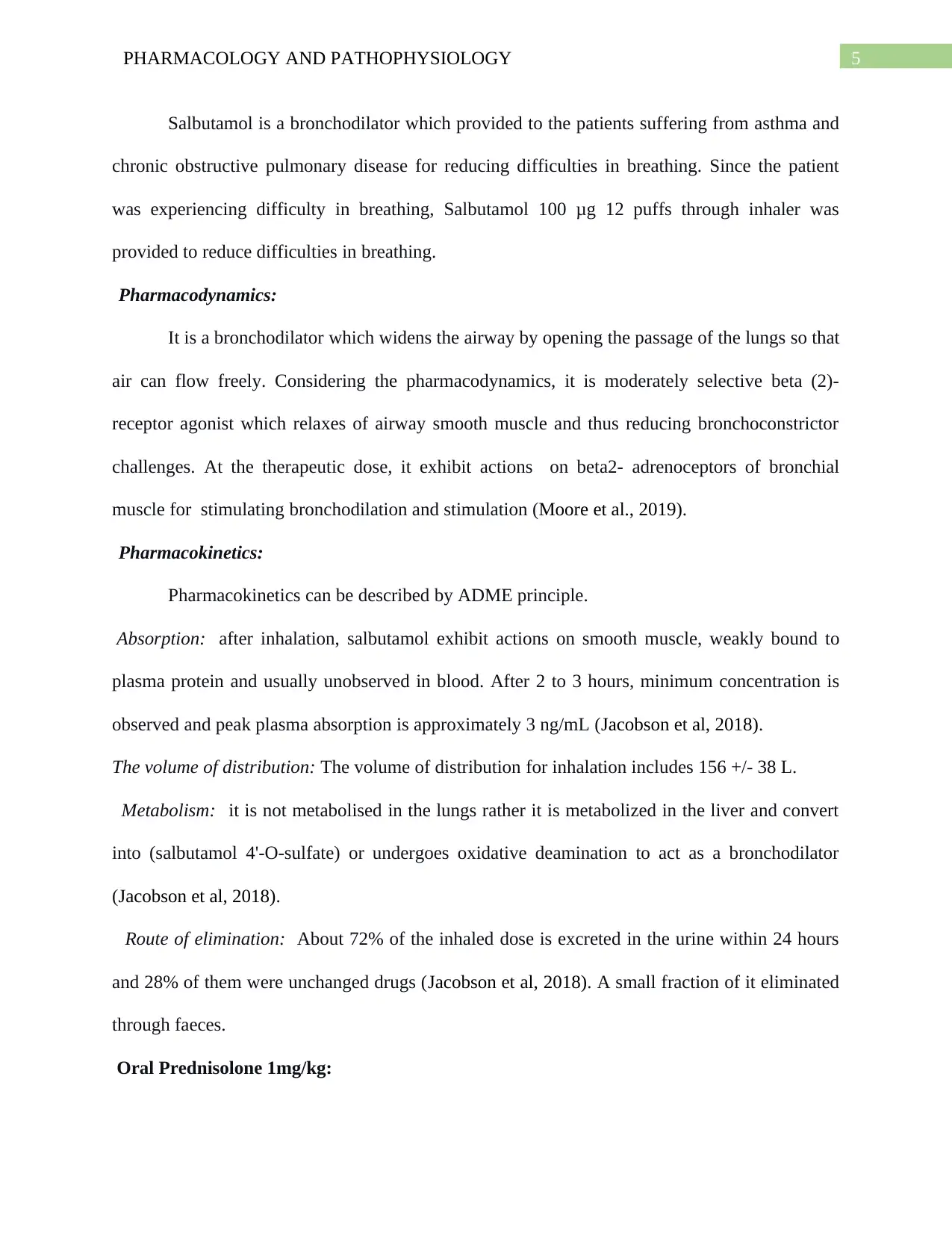
5PHARMACOLOGY AND PATHOPHYSIOLOGY
Salbutamol is a bronchodilator which provided to the patients suffering from asthma and
chronic obstructive pulmonary disease for reducing difficulties in breathing. Since the patient
was experiencing difficulty in breathing, Salbutamol 100 μg 12 puffs through inhaler was
provided to reduce difficulties in breathing.
Pharmacodynamics:
It is a bronchodilator which widens the airway by opening the passage of the lungs so that
air can flow freely. Considering the pharmacodynamics, it is moderately selective beta (2)-
receptor agonist which relaxes of airway smooth muscle and thus reducing bronchoconstrictor
challenges. At the therapeutic dose, it exhibit actions on beta2- adrenoceptors of bronchial
muscle for stimulating bronchodilation and stimulation (Moore et al., 2019).
Pharmacokinetics:
Pharmacokinetics can be described by ADME principle.
Absorption: after inhalation, salbutamol exhibit actions on smooth muscle, weakly bound to
plasma protein and usually unobserved in blood. After 2 to 3 hours, minimum concentration is
observed and peak plasma absorption is approximately 3 ng/mL (Jacobson et al, 2018).
The volume of distribution: The volume of distribution for inhalation includes 156 +/- 38 L.
Metabolism: it is not metabolised in the lungs rather it is metabolized in the liver and convert
into (salbutamol 4'-O-sulfate) or undergoes oxidative deamination to act as a bronchodilator
(Jacobson et al, 2018).
Route of elimination: About 72% of the inhaled dose is excreted in the urine within 24 hours
and 28% of them were unchanged drugs (Jacobson et al, 2018). A small fraction of it eliminated
through faeces.
Oral Prednisolone 1mg/kg:
Salbutamol is a bronchodilator which provided to the patients suffering from asthma and
chronic obstructive pulmonary disease for reducing difficulties in breathing. Since the patient
was experiencing difficulty in breathing, Salbutamol 100 μg 12 puffs through inhaler was
provided to reduce difficulties in breathing.
Pharmacodynamics:
It is a bronchodilator which widens the airway by opening the passage of the lungs so that
air can flow freely. Considering the pharmacodynamics, it is moderately selective beta (2)-
receptor agonist which relaxes of airway smooth muscle and thus reducing bronchoconstrictor
challenges. At the therapeutic dose, it exhibit actions on beta2- adrenoceptors of bronchial
muscle for stimulating bronchodilation and stimulation (Moore et al., 2019).
Pharmacokinetics:
Pharmacokinetics can be described by ADME principle.
Absorption: after inhalation, salbutamol exhibit actions on smooth muscle, weakly bound to
plasma protein and usually unobserved in blood. After 2 to 3 hours, minimum concentration is
observed and peak plasma absorption is approximately 3 ng/mL (Jacobson et al, 2018).
The volume of distribution: The volume of distribution for inhalation includes 156 +/- 38 L.
Metabolism: it is not metabolised in the lungs rather it is metabolized in the liver and convert
into (salbutamol 4'-O-sulfate) or undergoes oxidative deamination to act as a bronchodilator
(Jacobson et al, 2018).
Route of elimination: About 72% of the inhaled dose is excreted in the urine within 24 hours
and 28% of them were unchanged drugs (Jacobson et al, 2018). A small fraction of it eliminated
through faeces.
Oral Prednisolone 1mg/kg:
⊘ This is a preview!⊘
Do you want full access?
Subscribe today to unlock all pages.

Trusted by 1+ million students worldwide
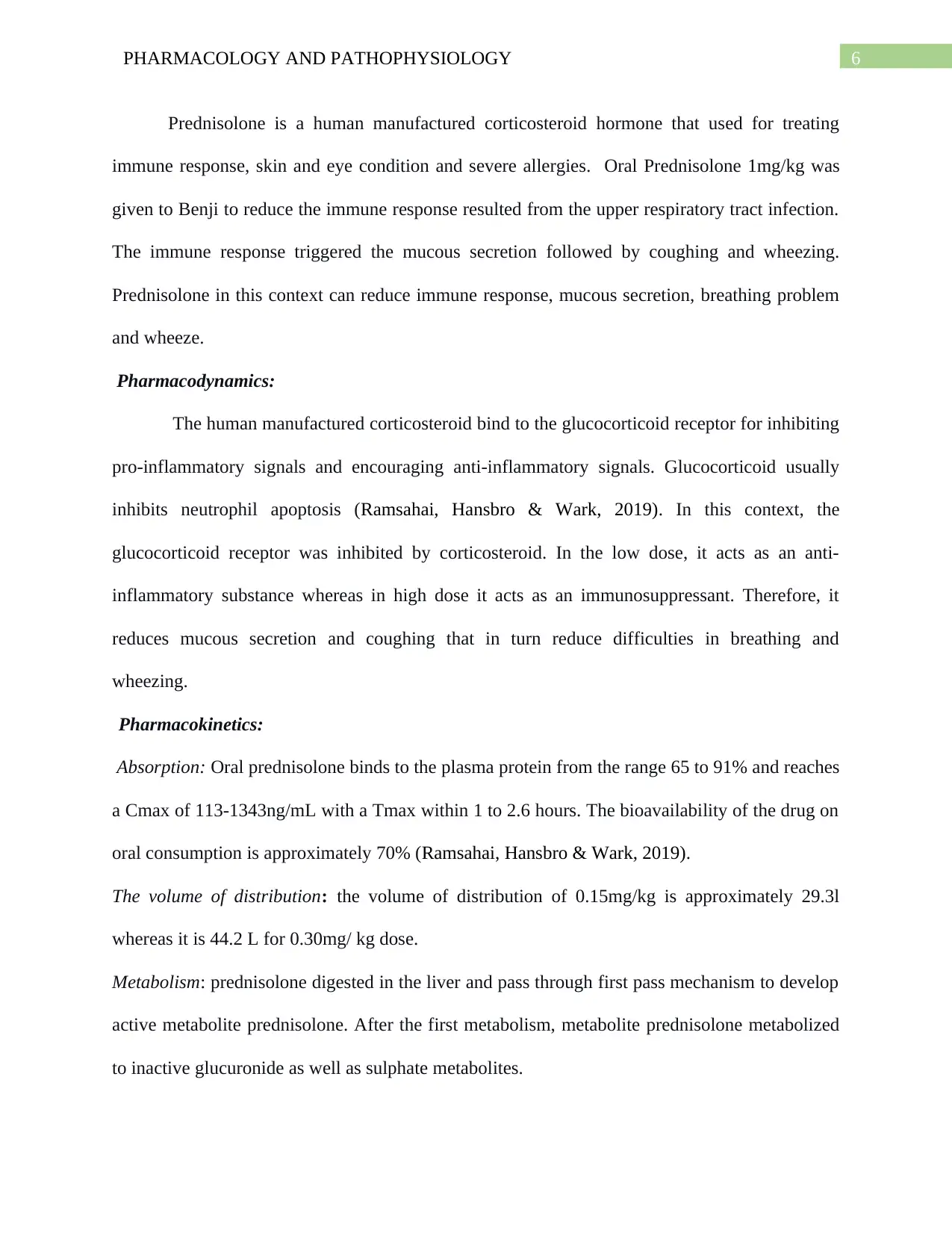
6PHARMACOLOGY AND PATHOPHYSIOLOGY
Prednisolone is a human manufactured corticosteroid hormone that used for treating
immune response, skin and eye condition and severe allergies. Oral Prednisolone 1mg/kg was
given to Benji to reduce the immune response resulted from the upper respiratory tract infection.
The immune response triggered the mucous secretion followed by coughing and wheezing.
Prednisolone in this context can reduce immune response, mucous secretion, breathing problem
and wheeze.
Pharmacodynamics:
The human manufactured corticosteroid bind to the glucocorticoid receptor for inhibiting
pro-inflammatory signals and encouraging anti-inflammatory signals. Glucocorticoid usually
inhibits neutrophil apoptosis (Ramsahai, Hansbro & Wark, 2019). In this context, the
glucocorticoid receptor was inhibited by corticosteroid. In the low dose, it acts as an anti-
inflammatory substance whereas in high dose it acts as an immunosuppressant. Therefore, it
reduces mucous secretion and coughing that in turn reduce difficulties in breathing and
wheezing.
Pharmacokinetics:
Absorption: Oral prednisolone binds to the plasma protein from the range 65 to 91% and reaches
a Cmax of 113-1343ng/mL with a Tmax within 1 to 2.6 hours. The bioavailability of the drug on
oral consumption is approximately 70% (Ramsahai, Hansbro & Wark, 2019).
The volume of distribution: the volume of distribution of 0.15mg/kg is approximately 29.3l
whereas it is 44.2 L for 0.30mg/ kg dose.
Metabolism: prednisolone digested in the liver and pass through first pass mechanism to develop
active metabolite prednisolone. After the first metabolism, metabolite prednisolone metabolized
to inactive glucuronide as well as sulphate metabolites.
Prednisolone is a human manufactured corticosteroid hormone that used for treating
immune response, skin and eye condition and severe allergies. Oral Prednisolone 1mg/kg was
given to Benji to reduce the immune response resulted from the upper respiratory tract infection.
The immune response triggered the mucous secretion followed by coughing and wheezing.
Prednisolone in this context can reduce immune response, mucous secretion, breathing problem
and wheeze.
Pharmacodynamics:
The human manufactured corticosteroid bind to the glucocorticoid receptor for inhibiting
pro-inflammatory signals and encouraging anti-inflammatory signals. Glucocorticoid usually
inhibits neutrophil apoptosis (Ramsahai, Hansbro & Wark, 2019). In this context, the
glucocorticoid receptor was inhibited by corticosteroid. In the low dose, it acts as an anti-
inflammatory substance whereas in high dose it acts as an immunosuppressant. Therefore, it
reduces mucous secretion and coughing that in turn reduce difficulties in breathing and
wheezing.
Pharmacokinetics:
Absorption: Oral prednisolone binds to the plasma protein from the range 65 to 91% and reaches
a Cmax of 113-1343ng/mL with a Tmax within 1 to 2.6 hours. The bioavailability of the drug on
oral consumption is approximately 70% (Ramsahai, Hansbro & Wark, 2019).
The volume of distribution: the volume of distribution of 0.15mg/kg is approximately 29.3l
whereas it is 44.2 L for 0.30mg/ kg dose.
Metabolism: prednisolone digested in the liver and pass through first pass mechanism to develop
active metabolite prednisolone. After the first metabolism, metabolite prednisolone metabolized
to inactive glucuronide as well as sulphate metabolites.
Paraphrase This Document
Need a fresh take? Get an instant paraphrase of this document with our AI Paraphraser
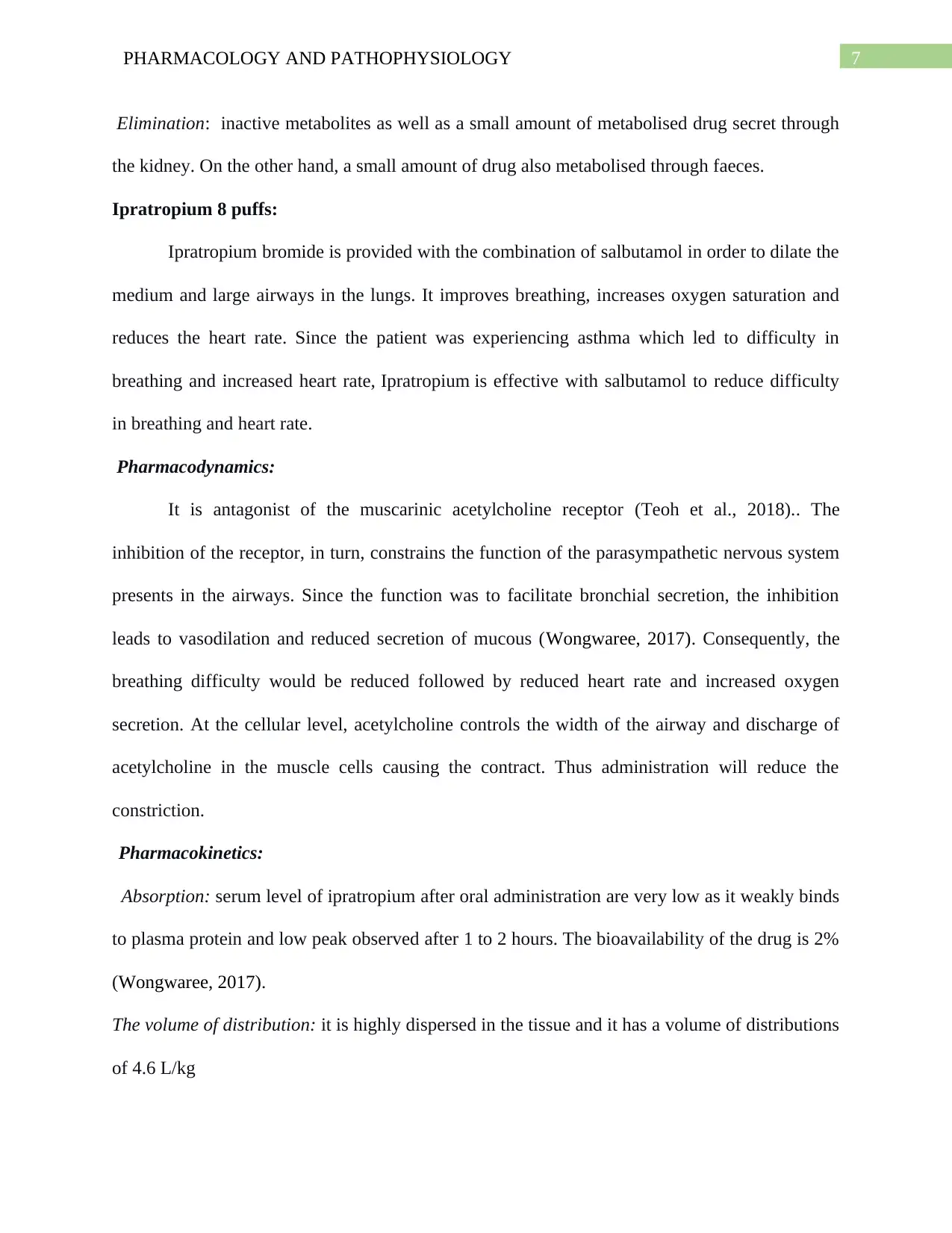
7PHARMACOLOGY AND PATHOPHYSIOLOGY
Elimination: inactive metabolites as well as a small amount of metabolised drug secret through
the kidney. On the other hand, a small amount of drug also metabolised through faeces.
Ipratropium 8 puffs:
Ipratropium bromide is provided with the combination of salbutamol in order to dilate the
medium and large airways in the lungs. It improves breathing, increases oxygen saturation and
reduces the heart rate. Since the patient was experiencing asthma which led to difficulty in
breathing and increased heart rate, Ipratropium is effective with salbutamol to reduce difficulty
in breathing and heart rate.
Pharmacodynamics:
It is antagonist of the muscarinic acetylcholine receptor (Teoh et al., 2018).. The
inhibition of the receptor, in turn, constrains the function of the parasympathetic nervous system
presents in the airways. Since the function was to facilitate bronchial secretion, the inhibition
leads to vasodilation and reduced secretion of mucous (Wongwaree, 2017). Consequently, the
breathing difficulty would be reduced followed by reduced heart rate and increased oxygen
secretion. At the cellular level, acetylcholine controls the width of the airway and discharge of
acetylcholine in the muscle cells causing the contract. Thus administration will reduce the
constriction.
Pharmacokinetics:
Absorption: serum level of ipratropium after oral administration are very low as it weakly binds
to plasma protein and low peak observed after 1 to 2 hours. The bioavailability of the drug is 2%
(Wongwaree, 2017).
The volume of distribution: it is highly dispersed in the tissue and it has a volume of distributions
of 4.6 L/kg
Elimination: inactive metabolites as well as a small amount of metabolised drug secret through
the kidney. On the other hand, a small amount of drug also metabolised through faeces.
Ipratropium 8 puffs:
Ipratropium bromide is provided with the combination of salbutamol in order to dilate the
medium and large airways in the lungs. It improves breathing, increases oxygen saturation and
reduces the heart rate. Since the patient was experiencing asthma which led to difficulty in
breathing and increased heart rate, Ipratropium is effective with salbutamol to reduce difficulty
in breathing and heart rate.
Pharmacodynamics:
It is antagonist of the muscarinic acetylcholine receptor (Teoh et al., 2018).. The
inhibition of the receptor, in turn, constrains the function of the parasympathetic nervous system
presents in the airways. Since the function was to facilitate bronchial secretion, the inhibition
leads to vasodilation and reduced secretion of mucous (Wongwaree, 2017). Consequently, the
breathing difficulty would be reduced followed by reduced heart rate and increased oxygen
secretion. At the cellular level, acetylcholine controls the width of the airway and discharge of
acetylcholine in the muscle cells causing the contract. Thus administration will reduce the
constriction.
Pharmacokinetics:
Absorption: serum level of ipratropium after oral administration are very low as it weakly binds
to plasma protein and low peak observed after 1 to 2 hours. The bioavailability of the drug is 2%
(Wongwaree, 2017).
The volume of distribution: it is highly dispersed in the tissue and it has a volume of distributions
of 4.6 L/kg

8PHARMACOLOGY AND PATHOPHYSIOLOGY
Metabolism: it is digested in the GI of human by cytochrome P-450 isoenzymes. Since the
bioavailability of the drug is low compared to other drugs, after the oral dose, approximately
90% of dose is excreted unchanged without metabolized into any other form of metabolites
(Wongwaree, 2017). On the other hand, the absorbed portion of the drug is partially metabolized
by ester hydrolysis for inactiving metabolites, tropic acid and tropane.
Route of elimination: approximately 80 to 100% of the dose is eliminated through urine
excretion and a small amount of the drug eliminate through faeces. The drug found in the urine
remains unchanged, indicating very low bioavailability (Wongwaree, 2017).
Metabolism: it is digested in the GI of human by cytochrome P-450 isoenzymes. Since the
bioavailability of the drug is low compared to other drugs, after the oral dose, approximately
90% of dose is excreted unchanged without metabolized into any other form of metabolites
(Wongwaree, 2017). On the other hand, the absorbed portion of the drug is partially metabolized
by ester hydrolysis for inactiving metabolites, tropic acid and tropane.
Route of elimination: approximately 80 to 100% of the dose is eliminated through urine
excretion and a small amount of the drug eliminate through faeces. The drug found in the urine
remains unchanged, indicating very low bioavailability (Wongwaree, 2017).
⊘ This is a preview!⊘
Do you want full access?
Subscribe today to unlock all pages.

Trusted by 1+ million students worldwide
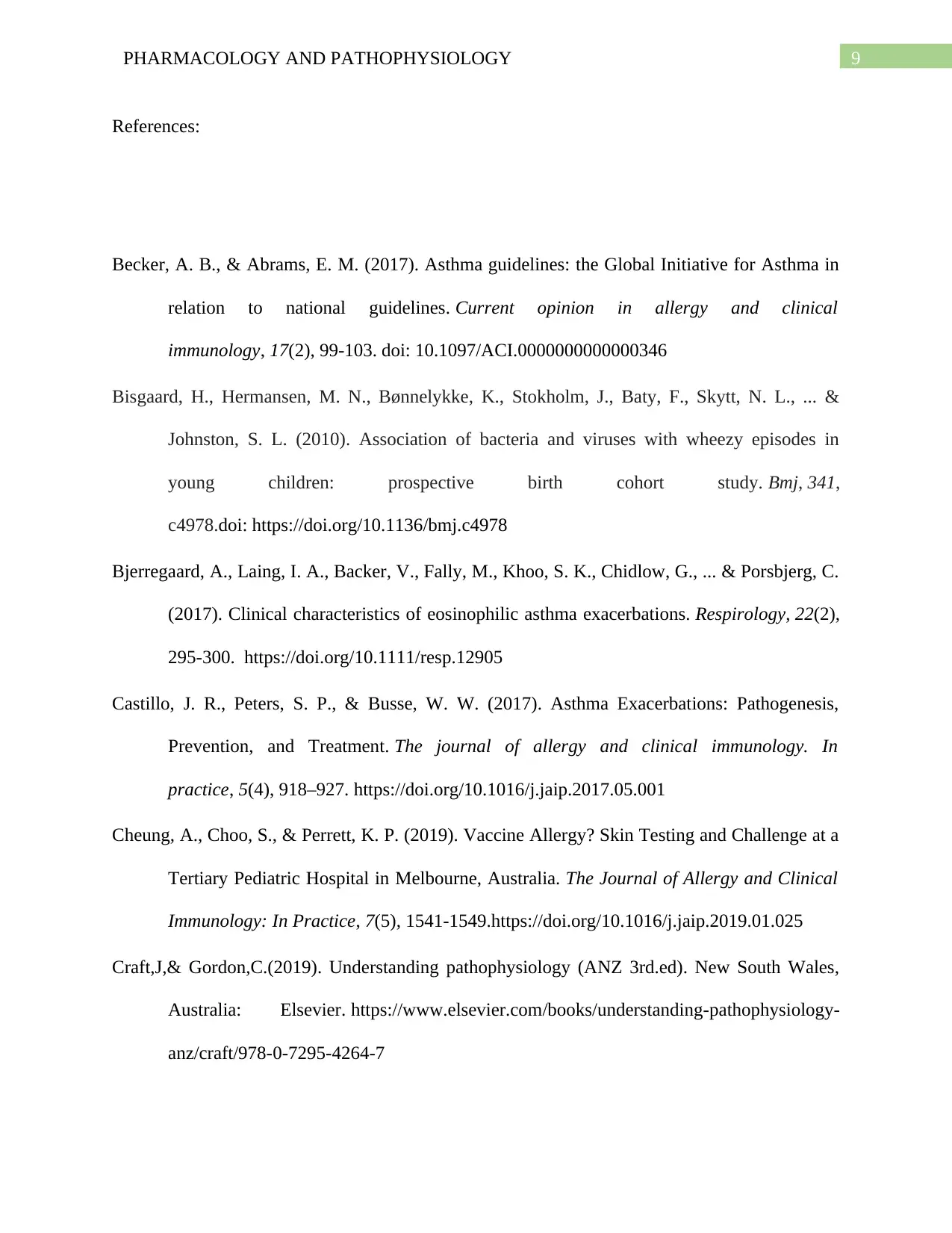
9PHARMACOLOGY AND PATHOPHYSIOLOGY
References:
Becker, A. B., & Abrams, E. M. (2017). Asthma guidelines: the Global Initiative for Asthma in
relation to national guidelines. Current opinion in allergy and clinical
immunology, 17(2), 99-103. doi: 10.1097/ACI.0000000000000346
Bisgaard, H., Hermansen, M. N., Bønnelykke, K., Stokholm, J., Baty, F., Skytt, N. L., ... &
Johnston, S. L. (2010). Association of bacteria and viruses with wheezy episodes in
young children: prospective birth cohort study. Bmj, 341,
c4978.doi: https://doi.org/10.1136/bmj.c4978
Bjerregaard, A., Laing, I. A., Backer, V., Fally, M., Khoo, S. K., Chidlow, G., ... & Porsbjerg, C.
(2017). Clinical characteristics of eosinophilic asthma exacerbations. Respirology, 22(2),
295-300. https://doi.org/10.1111/resp.12905
Castillo, J. R., Peters, S. P., & Busse, W. W. (2017). Asthma Exacerbations: Pathogenesis,
Prevention, and Treatment. The journal of allergy and clinical immunology. In
practice, 5(4), 918–927. https://doi.org/10.1016/j.jaip.2017.05.001
Cheung, A., Choo, S., & Perrett, K. P. (2019). Vaccine Allergy? Skin Testing and Challenge at a
Tertiary Pediatric Hospital in Melbourne, Australia. The Journal of Allergy and Clinical
Immunology: In Practice, 7(5), 1541-1549.https://doi.org/10.1016/j.jaip.2019.01.025
Craft,J,& Gordon,C.(2019). Understanding pathophysiology (ANZ 3rd.ed). New South Wales,
Australia: Elsevier. https://www.elsevier.com/books/understanding-pathophysiology-
anz/craft/978-0-7295-4264-7
References:
Becker, A. B., & Abrams, E. M. (2017). Asthma guidelines: the Global Initiative for Asthma in
relation to national guidelines. Current opinion in allergy and clinical
immunology, 17(2), 99-103. doi: 10.1097/ACI.0000000000000346
Bisgaard, H., Hermansen, M. N., Bønnelykke, K., Stokholm, J., Baty, F., Skytt, N. L., ... &
Johnston, S. L. (2010). Association of bacteria and viruses with wheezy episodes in
young children: prospective birth cohort study. Bmj, 341,
c4978.doi: https://doi.org/10.1136/bmj.c4978
Bjerregaard, A., Laing, I. A., Backer, V., Fally, M., Khoo, S. K., Chidlow, G., ... & Porsbjerg, C.
(2017). Clinical characteristics of eosinophilic asthma exacerbations. Respirology, 22(2),
295-300. https://doi.org/10.1111/resp.12905
Castillo, J. R., Peters, S. P., & Busse, W. W. (2017). Asthma Exacerbations: Pathogenesis,
Prevention, and Treatment. The journal of allergy and clinical immunology. In
practice, 5(4), 918–927. https://doi.org/10.1016/j.jaip.2017.05.001
Cheung, A., Choo, S., & Perrett, K. P. (2019). Vaccine Allergy? Skin Testing and Challenge at a
Tertiary Pediatric Hospital in Melbourne, Australia. The Journal of Allergy and Clinical
Immunology: In Practice, 7(5), 1541-1549.https://doi.org/10.1016/j.jaip.2019.01.025
Craft,J,& Gordon,C.(2019). Understanding pathophysiology (ANZ 3rd.ed). New South Wales,
Australia: Elsevier. https://www.elsevier.com/books/understanding-pathophysiology-
anz/craft/978-0-7295-4264-7
Paraphrase This Document
Need a fresh take? Get an instant paraphrase of this document with our AI Paraphraser

10PHARMACOLOGY AND PATHOPHYSIOLOGY
Demenais, F., Margaritte-Jeannin, P., Barnes, K. C., Cookson, W. O., Altmüller, J., Ang, W., ...
& Bisgaard, H. (2018). Multiancestry association study identifies new asthma risk loci
that colocalize with immune-cell enhancer marks. Nature genetics, 50(1), 42-53.
doi: 10.1038/s41588-017-0014-7
Jacobson, G. A., Raidal, S., Hostrup, M., Calzetta, L., Wood-Baker, R., Farber, M. O., ... &
Walters, E. H. (2018). Long-acting β2-agonists in asthma: enantioselective safety studies
are needed. Drug safety, 41(5), 441-449. https://doi.org/10.1007/s40264-017-0631-1
Moore, L. E., Kapoor, K., Byers, B. W., Brotto, A. R., Ghods-Esfahani, D., Henry, S. L., ... &
Stickland, M. K. (2019). Acute effects of salbutamol on systemic vascular function in
people with asthma. Respiratory medicine, 155, 133-140.
https://www.resmedjournal.com/article/S0954-6111(19)30242-2/fulltext
Owens, L., Laing, I. A., Zhang, G., & Le Souëf, P. N. (2017). Infant lung function predicts
asthma persistence and remission in young adults. Respirology, 22(2), 289-294. doi:
10.1111/resp.12901
Ramsahai, J. M., Hansbro, P. M., & Wark, P. A. (2019). Mechanisms and management of
asthma exacerbations. American journal of respiratory and critical care
medicine, 199(4), 423-432.
Tan, D. J., Burgess, J. A., Perret, J. L., Bui, D. S., Abramson, M. J., Dharmage, S. C., & Walters,
E. H. (2020). Non-pharmacological management of adult asthma in Australia: cross-
sectional analysis of a population-based cohort study. Journal of Asthma, 57(1), 105-112.
https://doi.org/10.1080/02770903.2018.1545030
Teo, S. M., Tang, H. H., Mok, D., Judd, L. M., Watts, S. C., Pham, K., ... & Bochkov, Y. A.
(2017). Dynamics of the upper airway microbiome in the pathogenesis of asthma-
Demenais, F., Margaritte-Jeannin, P., Barnes, K. C., Cookson, W. O., Altmüller, J., Ang, W., ...
& Bisgaard, H. (2018). Multiancestry association study identifies new asthma risk loci
that colocalize with immune-cell enhancer marks. Nature genetics, 50(1), 42-53.
doi: 10.1038/s41588-017-0014-7
Jacobson, G. A., Raidal, S., Hostrup, M., Calzetta, L., Wood-Baker, R., Farber, M. O., ... &
Walters, E. H. (2018). Long-acting β2-agonists in asthma: enantioselective safety studies
are needed. Drug safety, 41(5), 441-449. https://doi.org/10.1007/s40264-017-0631-1
Moore, L. E., Kapoor, K., Byers, B. W., Brotto, A. R., Ghods-Esfahani, D., Henry, S. L., ... &
Stickland, M. K. (2019). Acute effects of salbutamol on systemic vascular function in
people with asthma. Respiratory medicine, 155, 133-140.
https://www.resmedjournal.com/article/S0954-6111(19)30242-2/fulltext
Owens, L., Laing, I. A., Zhang, G., & Le Souëf, P. N. (2017). Infant lung function predicts
asthma persistence and remission in young adults. Respirology, 22(2), 289-294. doi:
10.1111/resp.12901
Ramsahai, J. M., Hansbro, P. M., & Wark, P. A. (2019). Mechanisms and management of
asthma exacerbations. American journal of respiratory and critical care
medicine, 199(4), 423-432.
Tan, D. J., Burgess, J. A., Perret, J. L., Bui, D. S., Abramson, M. J., Dharmage, S. C., & Walters,
E. H. (2020). Non-pharmacological management of adult asthma in Australia: cross-
sectional analysis of a population-based cohort study. Journal of Asthma, 57(1), 105-112.
https://doi.org/10.1080/02770903.2018.1545030
Teo, S. M., Tang, H. H., Mok, D., Judd, L. M., Watts, S. C., Pham, K., ... & Bochkov, Y. A.
(2017). Dynamics of the upper airway microbiome in the pathogenesis of asthma-
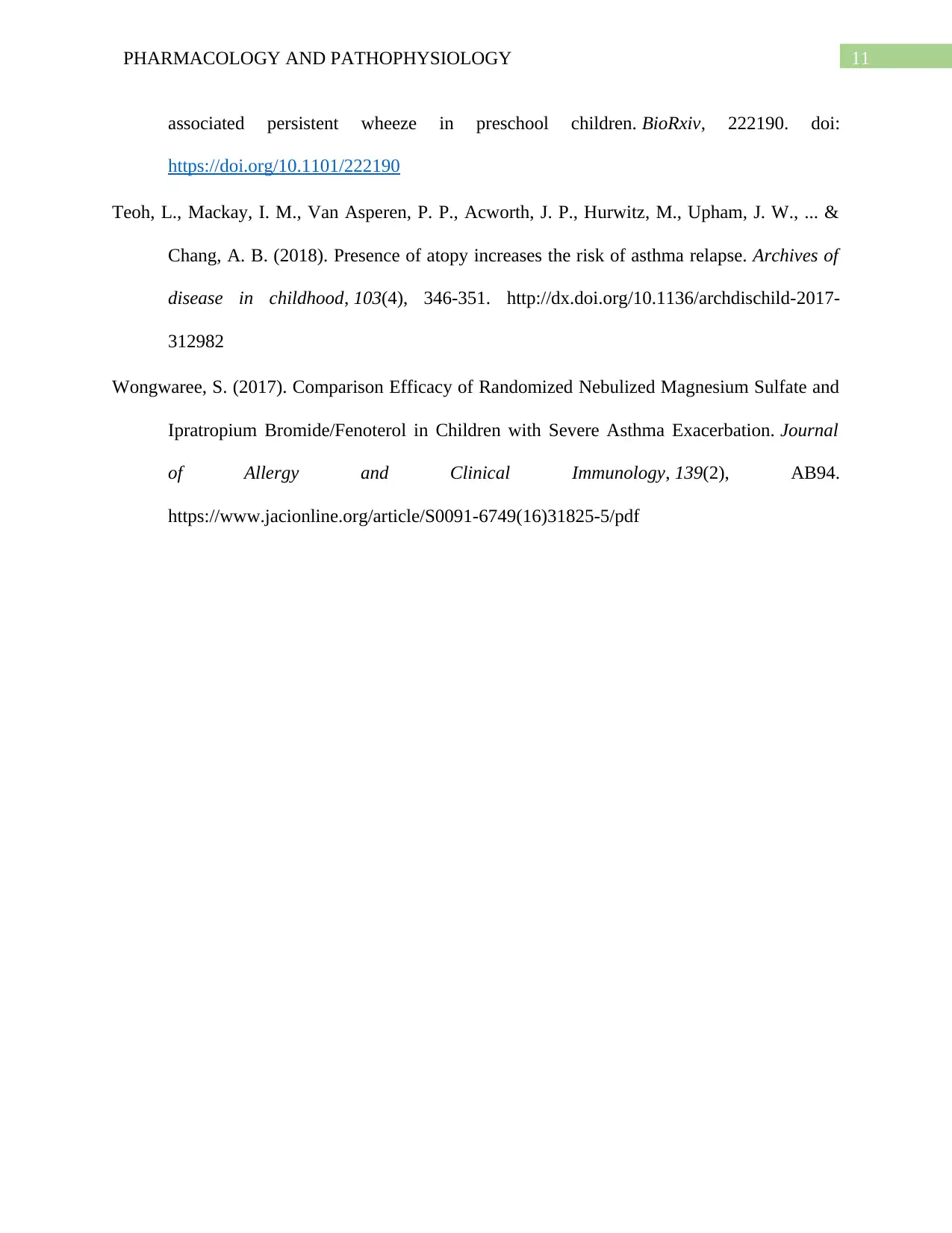
11PHARMACOLOGY AND PATHOPHYSIOLOGY
associated persistent wheeze in preschool children. BioRxiv, 222190. doi:
https://doi.org/10.1101/222190
Teoh, L., Mackay, I. M., Van Asperen, P. P., Acworth, J. P., Hurwitz, M., Upham, J. W., ... &
Chang, A. B. (2018). Presence of atopy increases the risk of asthma relapse. Archives of
disease in childhood, 103(4), 346-351. http://dx.doi.org/10.1136/archdischild-2017-
312982
Wongwaree, S. (2017). Comparison Efficacy of Randomized Nebulized Magnesium Sulfate and
Ipratropium Bromide/Fenoterol in Children with Severe Asthma Exacerbation. Journal
of Allergy and Clinical Immunology, 139(2), AB94.
https://www.jacionline.org/article/S0091-6749(16)31825-5/pdf
associated persistent wheeze in preschool children. BioRxiv, 222190. doi:
https://doi.org/10.1101/222190
Teoh, L., Mackay, I. M., Van Asperen, P. P., Acworth, J. P., Hurwitz, M., Upham, J. W., ... &
Chang, A. B. (2018). Presence of atopy increases the risk of asthma relapse. Archives of
disease in childhood, 103(4), 346-351. http://dx.doi.org/10.1136/archdischild-2017-
312982
Wongwaree, S. (2017). Comparison Efficacy of Randomized Nebulized Magnesium Sulfate and
Ipratropium Bromide/Fenoterol in Children with Severe Asthma Exacerbation. Journal
of Allergy and Clinical Immunology, 139(2), AB94.
https://www.jacionline.org/article/S0091-6749(16)31825-5/pdf
⊘ This is a preview!⊘
Do you want full access?
Subscribe today to unlock all pages.

Trusted by 1+ million students worldwide
1 out of 12
Related Documents
Your All-in-One AI-Powered Toolkit for Academic Success.
+13062052269
info@desklib.com
Available 24*7 on WhatsApp / Email
![[object Object]](/_next/static/media/star-bottom.7253800d.svg)
Unlock your academic potential
Copyright © 2020–2025 A2Z Services. All Rights Reserved. Developed and managed by ZUCOL.





